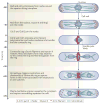Understanding cytokinesis: lessons from fission yeast
- PMID: 20094054
- PMCID: PMC2819279
- DOI: 10.1038/nrm2834
Understanding cytokinesis: lessons from fission yeast
Abstract
For decades after the discovery that a contractile ring made of actin filaments and myosin II produces the force to constrict the cleavage furrow of animal cells, the complexity of cytokinesis has slowed progress in understanding the mechanism. Mechanistic insights, however, have been obtained by genetic, biochemical, microscopic and mathematical modelling approaches in the fission yeast Schizosaccharomyces pombe. Many features that have been identified in fission yeast are probably shared with animal cells, as both inherited many cytokinesis genes from their common ancestor about one billion years ago.
Conflict of interest statement
The authors declare no competing financial interests.
Figures



References
-
- Gould KL, Simanis V. The control of septum formation in fission yeast. Genes Dev. 1997;11:2939–2951. - PubMed
-
- Wu JQ, Kuhn JR, Kovar DR, Pollard TD. Spatial and temporal pathway for assembly and constriction of the contractile ring in fission yeast cytokinesis. Dev Cell. 2003;5:723–734. - PubMed
-
- Wu JQ, Pollard TD. Counting cytokinesis proteins globally and locally in fission yeast. Science. 2005;310:310–314. - PubMed
Publication types
MeSH terms
Substances
Grants and funding
LinkOut - more resources
Full Text Sources

